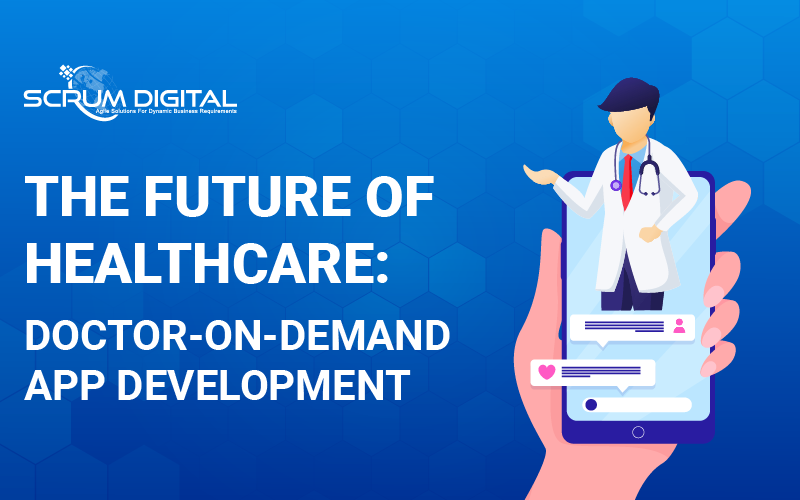The healthcare industry has come a long way in the past few decades, and technology has played a crucial role in shaping its evolution. According to Statista, the global mobile health market will exceed USD 300 billion by 2025. One of the most significant technological advancements in the healthcare sector has been the emergence of doctor-on-demand app development.
Healthcare apps are expected to reach USD 111.1 billion by 2025, with a CAGR of 38.26%, and the telemedicine market is expected to reach USD 460 billion by 2030.
Gone are the days when patients had to wait for hours in a crowded clinic or hospital to see a doctor. With the help of doctor-on-demand apps, patients can now easily access medical care from the comfort of their own homes.
Doctor on-demand app development has revolutionized the way healthcare is delivered, making it more convenient and accessible for patients. It has also helped to reduce the burden on healthcare providers by streamlining the appointment booking process and eliminating unnecessary visits to the clinic.
Consider the case of a busy working mother who has a young child with a fever. In the past, she would have had to take time off work and take her child to the clinic, where they would have to wait for an hour or more to see a doctor. With a doctor on-demand app, however, she can simply open the app, choose a suitable doctor, and book an appointment for a video consultation.
The consultation takes place in real-time over a secure video call, and the doctor is able to diagnose and prescribe medication for the child. All of this can be done from the comfort of the mother’s home, saving her time and stress.
This is just one example of how doctor-on-demand app development is transforming the healthcare industry and making it more accessible and convenient for patients. In the coming years, we can expect to see even more advancements in this field, Here are a few benefits of doctor-on-demand mobile applications –
Benefits of Doctor-on-demand Mobile Applications
1. Increased Accessibility
Doctor-on-demand apps can be particularly useful for people who live in rural or underserved areas, or for those who have difficulty leaving their homes due to illness or disability. These apps can also be helpful for people who need to see a doctor urgently but are unable to get an appointment with their regular physician.
Doctor-on-demand apps can provide a variety of medical services, such as consultations with doctors or other healthcare professionals, prescription refills, and even telehealth visits for certain conditions.
Some apps may also offer additional services such as booking appointments for in-person visits, ordering lab tests, or providing access to medical records and other health information.
Overall, doctor-on-demand apps can help to increase the efficiency and effectiveness of the healthcare system by allowing more people to receive care in a timely manner, and by reducing the overload on healthcare systems.
2. Improved Efficiency

Doctor-on-demand apps can help to streamline the process of receiving medical care by eliminating some of the administrative tasks that can be time-consuming and inconvenient. For example, patients can use the app to schedule appointments, fill out the necessary paperwork, and provide their medical history and other relevant information.
This can help to reduce wait times and ensure that appointments are more productive, as doctors can review the patient’s information in advance and be better prepared for the visit.
Additionally, doctor-on-demand apps can help to reduce the number of missed or canceled appointments, which can be a significant problem in the healthcare system. Using the app, patients can reschedule appointments easily, which can reduce the number of “no-shows” and improve overall efficiency.
Overall, doctor-on-demand apps can help to improve the patient experience by making it easier to access care, while also helping to increase the efficiency and productivity of healthcare providers.
3. Reduced Costs
Doctor-on-demand apps can be a cost-effective option for both doctors and patients. For doctors, these apps can help to reduce overhead costs by eliminating the need for a physical office location.
This can be especially beneficial for doctors who are just starting out or who are looking to expand their practice without incurring additional costs. For patients, doctor-on-demand apps can offer a more convenient and affordable alternative to traditional medical care.
Many apps offer services on a subscription or pay-per-use basis, which can be more affordable than paying for individual visits to a doctor’s office. Additionally, some apps may offer discounts on prescription medications, which can help to lower overall healthcare costs.
4. Improved Patient Care

Doctor-on-demand apps can help to improve patient care by providing doctors with more information about their patients before the appointment. By allowing patients to input their medical history and other relevant information into the app, doctors can review this information in advance and be better prepared for the visit.
This can help to improve the accuracy of diagnoses and treatment plans, and can also help to reduce the risk of errors or unnecessary care. In addition to providing doctors with more information about their patients, doctor-on-demand apps can also improve patient care by offering telemedicine features such as video conferencing.
These features allow doctors to conduct remote consultations with their patients, which can be especially useful for patients who are unable to travel or who live in rural or underserved areas.
Telemedicine can help to reduce waiting times between appointments and can make it easier for patients to receive care when they need it
5. Convenience
Convenience is a major benefit of doctor-on-demand apps and is likely one of the main reasons why people choose to use these apps. With a doctor-on-demand app, patients can access their medical records, schedule appointments, and communicate with their doctors all from the comfort of their own homes.
This can be especially useful for people who have busy schedules, who live in rural or underserved areas, or who have difficulty leaving their homes due to illness or disability.
By having all of their medical information stored in one secure platform, patients can easily access their records anytime, which can be especially useful for managing chronic conditions or for tracking their health over time.
Similarly, the ability to schedule appointments and refill prescriptions online can be a huge time-saver, as it eliminates the need to make multiple trips to the doctor’s office or pharmacy.
Overall, doctor-on-demand apps offer a convenient and efficient way for patients to receive medical care and manage their health.
Development Tips For Building a Healthcare Mobile App

1. Research the Market
Before you begin, you should research the market thoroughly. See which features are popular in other apps that offer similar services, as well as what types of features users find useful and beneficial.
This will give you an idea of what kind of features you should include in your own app. You can also look at how other apps have succeeded and failed in order to avoid any mistakes they may have made while developing their own apps.
2. Develop a Strong User Interface
A user-friendly interface is essential for any successful app, especially one related to healthcare services. Make sure your design allows users to access all the necessary information quickly and easily, including contact details for doctors, appointment dates and times, etc.
Also, consider adding features such as automated reminders for upcoming appointments or notifications about changes in services or availability so users can stay up-to-date with all the latest information from their doctor’s office or clinic.
3. Utilize Security Measures
When handling sensitive data such as patient records or financial information, it is important to ensure that your app is secure from potential hackers or malicious software attacks.
Make sure you use strong encryption protocols and authentication measures when dealing with sensitive data so that patients’ records remain safe and secure at all times
4. Ensure Compatibility with Different Devices
One of the most important aspects of an app is its compatibility across different devices and platforms such as iOS and Android phones/tablets, computers (Mac/Windows), etc., so be sure to test your app on multiple devices before launching it into the market to ensure a consistent user experience across different platforms
5. Create an SEO-Friendly Design

SEO (Search Engine Optimization) friendly designs are essential for any successful app in today’s competitive marketplace; they help increase visibility on search engines like Google by making sure certain keywords related to your service appear prominently in website content or metadata tags associated with your site/app page(s).
This will help potential customers find your service more easily when searching online for relevant items related to healthcare services (i.e., “doctor appointment apps”)
Read Also: Medical Chatbots: The Future of the Healthcare Industry
6 Test Your App Thoroughly
Last but not least, make sure you test your app thoroughly before releasing it into the market; this includes testing on different devices/platforms mentioned above as well as running stress tests on servers where user data is stored or processed (if applicable).
Also, consider getting feedback from real users through beta testing programs prior to launch; this will help make sure any issues are addressed before releasing a final version of your product into the wild!
Doctor-on-demand apps have the potential to revolutionize the way healthcare is delivered. These apps can help to reduce the burden on the healthcare industry run by traditional healthcare systems, as they allow patients to receive care without having to visit a hospital or clinic.
This can help to reduce wait times and improve the overall efficiency of the healthcare system. In addition, these apps can often offer a more convenient and flexible way for patients to receive care, as they allow patients to schedule appointments and receive treatment at a time that is convenient for them.
Ready to take the next step in transforming the healthcare industry with a doctor-on-demand app? Contact our team of experts today to discuss how we can bring your vision to life and bring convenience and accessibility to your patients. Click here to get started.


